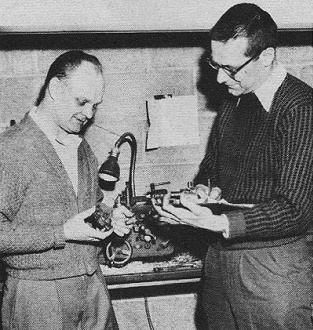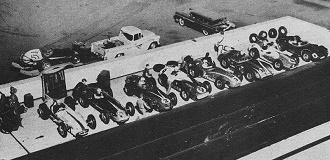|
Ah, the simpler
times when enjoyment, competition, and industry could be found on a slot car race
track in a musty basement. Pre-fab models were rare in the day, and those that could
be bought couldn't hold a candle to those hand crafted by young men like the ones
in these photos. It was not a pastime only for the younger set, though. Older guys
with metal lathes and fine crafting tools created museum quality masterpieces. This
"International Miniature Racing" article from the August 1962 issue of American
Modeler magazine reports on worldwide interest in slot car racing. I'm always
amazed at how many men and boys wore sport coats and ties while participating not
just in formal events, but even during everyday activities.
International Miniature Racing

Heading down the back stretch past pit area at Glen Allen's Pompton
Plains race track, three drivers (seated) jockey their cars for position in a "running"
start.
Four days after the TV program Wide World of Sports showed an hour and a half
of top-notch Indianapolis type racing on the Trenton Speedway, we jazzed the throttle
of a battered veteran of many races and eased it out of the pit area and onto the
back stretch of a similar oval.
A few warm-up laps to get the "feel" of the car and we were ready to see what
we could accomplish in the way of speed. Off the far turn and into the back stretch,
we slowly increased our speed to 90 ... 100 ... 110 ... 120 ... 130 ... 140 ...
and then into the near turn and through ... flashing past the starting line at 160
and up into the far turn again at close to 180! Out of the turn and down past the
pits at 200 ... ease up at the end of the straight and pour on the coal when into
the turn ... out of the turn and across the finish line at almost 240 miles per!
This was our introduction to the fascinating miniature racing world of Glen Allen
and his 15 year old slot racing oval, home of the oldest slot racing club in the
United States.
Located in Pompton Plains, New Jersey, Glen's three lane 1/24th scale track was
erected and put into operation long before most of us had ever heard of slot racing.
Compared to his modern 1962 racing machines, Glen's antiques of 15 years ago were
crude affairs designed around discarded HO train motors. As a matter of fact, Glen
credits the basic lack of speed of HO equipment as the motivating factor in the
building of his track.
Having evolved from these relatively crude cars (which now reside in glass cases
near the track ... a sort of private Cooperstown for the fans of oval slot racing)
with rear wheel drives, through stages of front wheel drives, independent suspension
systems, torsion bars, Glen's modern cars show an impressive improvement.

Rolf Rosengren with his original carrying case and 1/24th scale
cars.
Powered by either two Pittman 703 or 704 motors, these new cars feature four
wheel drive and ride on Veco rubber all the way around. At the moment, 703's are
the preferred motors due to the "built-in" 4 to 1 gear ratio which gives the best
results, but with a new track on the drawing board, 3:1 of the new Pittman 704 may
provide some different answers.
Two pins ride in the slot, the front one stationary, the rear one spring-loaded
to permit a controlled slide on the banked turns as well as to eliminate any fish-tailing
as the cars hit the straightaways under full power.
Models are powered by electric motors; "juice" is picked up from slots.
Unusual in the sense that no commercial manufacturer has picked up the idea,
the cars of this ancient club (it may only be 15 years old, but it was still way
ahead of its time) use two whiskers that ride against the sides of the slot to pick
up the current. Metal strips which line the sides of the slot don't detract from
the realism of the roadbed as does most commercial track which has the pick-up strip
on the surface of the track. Further, no matter how much bouncing these cars do,
short of flying completely off the track, a steady flow of current is assured.
The fifteen years of experience also shows up in the construction of the Guide
Pins which, again unlike commercial products, revolve around a center post. In short,
the friction of a stationary metal or plastic nub extending down into the slot is
overcome to a great extent by making a rolling bearing out of the post.
Car frames are all brass-weight is not much of a disadvantage on Glen's track
and is needed because of the excessive high speeds - and car bodies run from stock
Lindberg, Merit, Monogram, Strombecker, to very highly modified versions of the
same manufacturers' plastic offerings. Outstanding are a number of original body
designs which started out with the, bottom half of Monogram's Indy Pacer kits and
which have been altered to become unique and beautiful top shells.
Average car life is about one year with the bodies lasting one third that time.
Racing seasons start the first Thursday evening after Labor Day and continues weekly
through the last Thursday in April. Heats, semi-finals, and consolation races are
all 10 laps, feature races run 15. Starts of all races are "running," similar to
the big cars at Indy. Trophies are awarded at the end of the season and are paid
for out of the 50¢ per night entry fee. Half this fee goes to the trophy fund, the
other half for track maintenance and upkeep, and each evening's concluding refreshments.

"Scoop" Schwarzchild gets dope from Mr. Allen on his vehicles.

Close up of the Pit Area at Jersey track is complete with miniature
drivers, even tiny scale welding equipment. Photos by Brandt & Associates, Morristown,
N. J.
So much for the cars ... now to the track. Scheduled for a complete rebuilding
this summer to accommodate ever increasing speeds, the present lay-out measures
20 feet by 8 feet. Surface is plywood with three operating lanes. Turns are banked.
Current can be varied from zero to over 20 volts DC; three 40 ohm rheostats serve
to meter the juice to the track. Drivers SIT during competition with their heads
slightly above the level of the track, increasing the illusion of racing actual
cars. Tight chicken wire fencing about one foot high extends around three quarters
of the outside of the track to catch the somersaulting cars which result from contact
in the turns at high speeds as well as from broadsides in the straights. The only
unprotected area is down the back stretch where the drivers sit and peer over the
layout.
On the night we sat behind the wheel of one of Glen's "bombs," time trials were
running in the high eight second and low nine second areas. Timing, interestingly
enough, was done with a mechanical set-up which tripped a stop watch at the start
of a three lap run and which tripped it again at the end of the run. The watch held
in this unique contraption was calibrated to 0.100's of a second. Even though it
was hard to imagine cars going faster than the ones we watched, back in 1956 a course
record of 7.56 was set for a three lap timed run. Get out your slide rules ... two
sixteen foot straights and two four foot radius turns add up to about 56 feet per
lap ... you work out the rest!
Four hours after our arrival the field had narrowed down to three cars and drivers.
When the dust settled after 15 scorching laps in the feature, Bob Bratton of Jersey
City (who travels 35 miles to get to the track each race night) had flashed across
the finish line in first place followed closely by track owner and designer Glen
Allen. Joe Sampios brought up the rear.
Fifteen years ago a group of "advanced thinkers" got together to form this racing
organization. Today, eight of those original members are still active in the club,
a group whose ages run from 21 to slightly past 50 (no one would give a precise
figure on the oldest member). If you happen to be within 100 miles or so of Pompton
Plains, why not stop in at 19 Lockwood Avenue about 8:00 on the first Thursday after
Labor Day and watch the action. If you should catch the same strain of virus that
bit Glen Allen some 15 years ago, we're sure he'll be happy to welcome you to the
"oldest slot racing club in America."
Posted April 9, 2018
|



